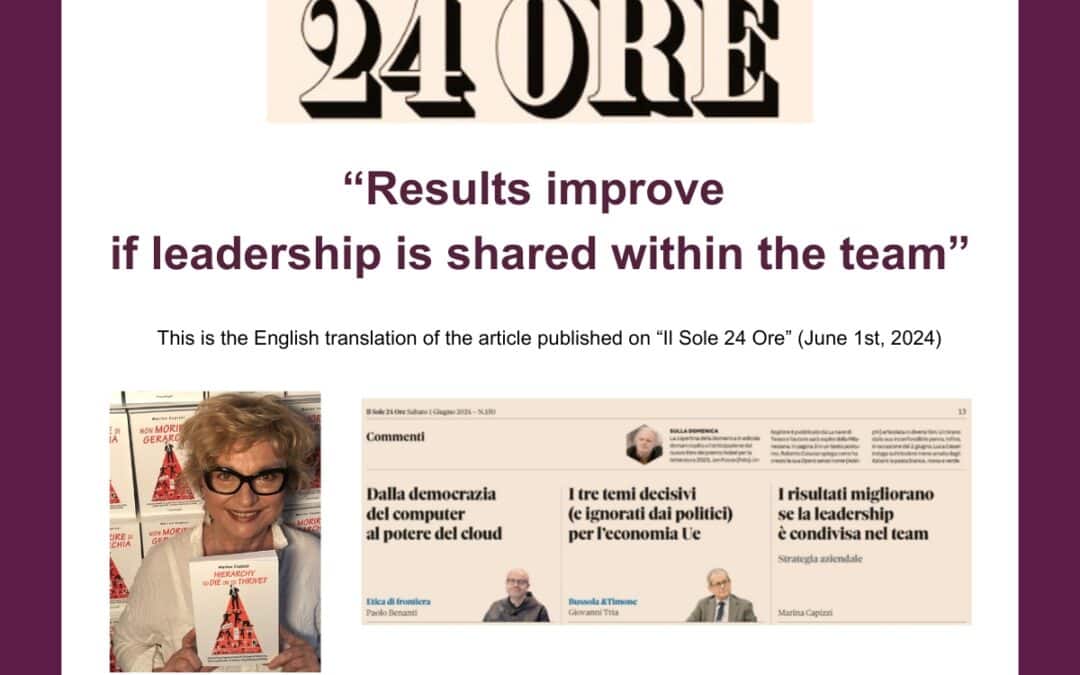(This article has been translated from “Il Sole 24 Ore”, the most important Italian economic newspaper. You can read the original here)
The traditional hierarchy is based on the individual. Goals are individual, individual results are evaluated and rewarded; only individual potential is considered. Leadership also continues to be considered a characteristic of the individual (how many times have we asked ourselves “are leaders born or made?”) and leadership courses are only for managers. But there is no such thing as individual-only performances, and results are not generated by bosses alone. Products and services come to market thanks to a multitude of people belonging to different functions. And when excellent results are achieved, it is always because people have found a way to work together.
Unfortunately, the traditional pyramid makes collaboration structurally difficult, because decision-making power increases by going up in the hierarchy and is allocated to individual roles, and this creates fragmentation, disconnections, and a lot of bureaucracy, making organizations slow and inefficient at both the top and bottom. At the top, because those who have decision-making power but do not directly experience problems and opportunities with customers, favor partisan logics and fuel internal conflicts that kill dialogue, create silos and fractures in workflows. At the bottom, because people perform fragmented tasks that they are often unclear about, and thus become demotivated or find alibis or are frustrated by the lack of listening and not being able to solve problems and seize opportunities that they experience every day with customers.
This approach is falling apart, but for companies, investing in bosses’ leadership continues to be more important than how people achieve results together. Some companies, however, have taken a different path in the allocation of decision-making power and the design of leadership, shifting the focus from the individual to the Team and shortening the distance between problems, opportunities, and decisions. Basically, they invest in self-governing Teams that make autonomous decisions and exercise Team leadership. This, for example, is the path taken by a well-known multinational health and nutrition company.
Bill Anderson talked about this in an interview with Fortune on March 2nd. The path has already been taken and will put 95 percent of decisions in the hands of the Teams that actually do the work. The annual budget process, for example, is being replaced with 90-day “sprints” managed directly by the Teams. Already 300 Teams operate in this way but by the end of the year it will be tens of thousands. What is expected from this transformation? The creation of a dynamic environment capable of adapting quickly, where people and their ideas can thrive without being hampered by bureaucracy. The goal is to free up energy and resources to create value. Even important business consulting majors, which for decades focused only on creating shareholder value and pushed managers to a command-&-control approach that fueled a competition- driven way of working, are now inviting companies to reinvent their business model by creating self- managed Teams where collaboration and authentic communication can be cultivated. And, as is in their DNA, they propose a predefined intervention model to achieve this result. In short, the new path is officially open. For now, only a few companies have decided to take it, but the evolution of the traditional hierarchy will be the challenge for everyone in the coming years. It is not an easy path, but results are not long in coming.
The most powerful ally is the desire for well-being that is now widespread at all levels of the organization. The first to be tired of the traditional hierarchy are precisely the leaders even if, admittedly, they are not comfortable in this change. But in modernity it is strategic to consider the team as the basic unit of organizations, and to put it in a position to act and grow. It is about helping managers take a step back and Teams take a step forward, both redefining their roles and co-designing an evolutionary path that considers the characteristics and potential of each company. If people work better together, results improve. We are at the dawn of a transformation where we are all pioneers, but we are accumulating important experiences to face this evolutionary leap with sufficient serenity.
Marina Capizzi, author of Hierarchy to Die or to Thrive?
